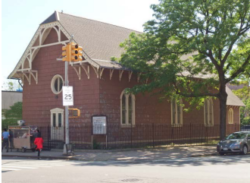
Old Saint James Episcopal Church at 86-02 Broadway in the Elmhurst section of Queens. Image credit: LPC
No objections to designation raised at hearing; concerns about closeness of potential development on undesignated portion of lot to church building raised by Commissioners. On August 8, 2017, Landmarks held a hearing on the potential designation of the Old Saint James Episcopal Church at 86-02 Broadway in the Elmhurst section of Queens. Landmarks added the 1736 building to its calendar at its June 27, 2017, meeting. The building is the second oldest surviving religious structure in the City, predated only by the 1694 Friends Meeting House in Flushing, an individual City landmark. The western portion of the lot on which the church sits is paved and used as a parking lot, and would not be included in the designation.
In the 17th century, Anglicans in the area, then known as Newtown, worshiped in a meeting hall shared by other denominations. After the formation of a parish and the assignation of a dedicated minister, the timber-framed vernacular church was built in the style of classic meeting hall, clad in shingle with a single tower facing the graveyard.
The building survived the Revolutionary War, and became one of the earliest members of the New York Episcopal Diocese. The congregation outgrew the building, and in 1848, it was converted to parish hall and a larger church was constructed nearby. The building was remodeled after the west end tower collapsed in a storm, with Carpenter gothic detailing, a shed-roof porch and decorative brackets.
The building lost many of its characteristics in the 20th century, but in 2004 it was restored to its 1884 appearance with the cooperation of and grants from the New York Landmarks Conservancy.
The border of the designation would extend five feet around the building to preserve all facades.
Reverend Andrew Durbridge, Real Estate Manager for the Episcopal Diocese of Long Island said that landmarking would increase maintenance costs, draining money that would otherwise go toward furthering the church’s ministry. Nonetheless, he said the Diocese supported the preservation of the heritage of the City and Episcopal Church, and did not object to the designation. Durbridge stated that the Diocese intended develop the unoccupied portion of the lot to generate revenue, as well as renovate the church to provide community space, and hoped Landmarks would work with the church to prevent the project from incurring excessive expenses. Brendan Coburn, of CWB Architects, retained by the church for the redevelopment project, supported designation, and said the church needed to be “sensitively adapted” to modern usage.
Andrea Goldwyn of the New York Landmarks Conservancy discussed the Conservancy’s work with the congregation to prevent demolition and restore the church to its late 19th century condition, through its Sacred Sites program. The work entailed the removal of asbestos siding and the restoration of cedar shingles, wood windows, and wood brackets and decorative trim. She said the building merits designation architecture and its connection to the history of Queens. Patrick Waldo, speaking for the Historic Districts Council, said designation would further Landmarks’ “commitment to reaching out to under-represented communities for landmark designation.” Waldo said the building possessed significance for its role in the community’s social history and its “remarkable, nearly 300-year existence in our great City.”
Chair Meenakshi Srinivasan stated that the commission had received letters in support of designation from the Queens Preservation Council, the Newtown Historical Society, the Juniper Park Civic Association, and Communities of Maspeth and Elmhurst Together.
Commissioner Michael Devonshire expressed concern about the five-foot buffer between the church and any potential development of the undesignated portion of the lot, saying the buffer should be increased to ten feet. He said the five foot buffer around the Coignet Building had allowed a situation where the surrounding Whole Foods Market “engulfs” the landmark.
Chair Srinivasan said the item had calendared with a five foot buffer, so that was the proposal under considers. She stated that zoning prevented high-density development at the site, that the parking lot had no historical value, that the agency wanted the church to be able to pursue its mission, and that the five feet was “a very rational boundary.” Executive Director Sarah Carroll noted that below-grade subway tracks made immediately adjacent development unlikely, and any development would probably be closest to the rear of the church, leaving the side facades completely visible.
Srinivasan said the item would be brought back in September for a vote on designation.
LPC: Old Saint James Episcopal Church, 86-02 Broadway, Queens (LP-2593) (August 8, 2017).
By: Jonathon Sizemore (Jonathon is the CityLaw Fellow and a New York Law School Graduate, Class of 2016).

